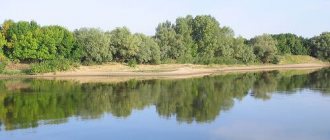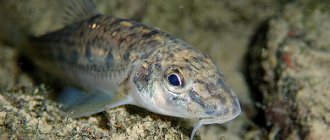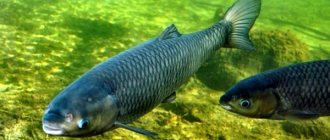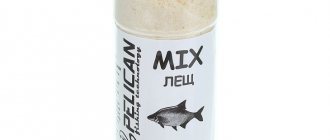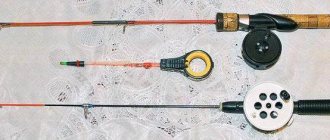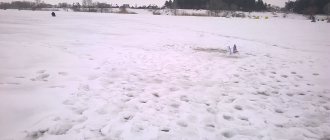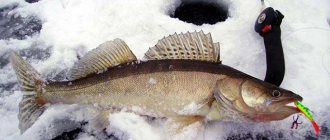Description and lifestyle
Ruff Ruff
is a fish of the perch family (gymnocephalus cernua).
The body of the ruff
is compressed from the sides. It is covered with small, tightly fitting scales, the edges of which have denticles. The head is not covered with scales. The lateral line is complete. The snout is blunt. The mouth is small and retractable. The eyes are big. The dorsal fin is one, fused from two. Its front part, slightly rising above the back, consists of spiny rays, the back - of soft ones. Spiny rays are also present in the ventral and anal fins.
The body color is dark gray, with a large number of dark spots and dots, most of which are on the upper half of the body, as well as on the dorsal and caudal fins. The back is grayish-green, the sides are yellowish-green, the belly is greenish-white. The eyes are yellow. The color of the ruffe may vary somewhat, depending on the color of the bottom soils. On sand its color is lighter than on silty soils.
The ruff leads a bottom-dwelling lifestyle. It stays in relatively deep places with a sandy or somewhat silty bottom in both lakes and rivers, where it avoids areas with strong currents. Prefers quiet and deep reaches near steep banks, steep places, near bridges and other structures. The ruffe lives in flocks consisting of individuals of different sizes. He rarely leaves his favorite places. The ruffe leaves its pits only during the breeding season, when it enters the floodplain, often meeting at spawning sites with other species of fish. On dark nights, ruffs emerge from deep areas to the spits. On bright moonlit nights such movements are not observed.
The ruff reaches sexual maturity in the second or third year of life. It spawns at a water temperature of 5-8 degrees on hard sandy soils among vegetation, at depths of up to 1.5 m. It lays eggs in portions, and therefore its spawning is very extended. Fecundity is relatively high.
The ruffe feeds on bottom organisms, including insect larvae and pupae, worms, small crustaceans, water donkeys and others. These same organisms are consumed by more valuable fish species, such as bream. In this regard, a large number of ruffe can limit the nutrition of bream and other more valuable fish species.
Spawning
Sexual maturity occurs early (at 1-3 years) with a body length of 8-12 cm. Productivity depends on the size of the female and varies between 10-200 thousand eggs, which spawn in 2-3 stages (from March to June), with In this case, heating the water is of secondary importance. Full development of larvae (5-12 days) is possible in a wide temperature range of +6-18°C. In addition, ruffes are maximally adapted to high acidity values (up to pH = 10.5), which allows them to successfully continue their genus in conditions that are unacceptable for other fish.
Sticky yellow eggs with a diameter of 0.8-1.0 mm are deposited on solid bottom substrate and underwater areas of plants. The average depth of spawning grounds is 1-2 meters. After spawning, the males remain near the clutch and protect future offspring from predators. The hatched larvae develop due to the yolk bladder. The swimmable fry actively eats zooplankton, copepod and chironomid larvae, and rotifers.
Fishing places
For many fishermen, the question of where to look for ruff may seem like a complete mockery. Ruff
- the last fish that an angler dreams of when going fishing. And in vain. Firstly, the ruff, even in small quantities, is able to give the ear the desired taste and aroma (the ruff is not cleaned of scales and mucus for cooking - this is where the secret of the aroma of this fish lies). Secondly, it is an almost ideal live bait for burbot, pike, and pike perch.
Ruffe are fished in all European and Siberian rivers, with the exception of the Amur basin and northern fast-flowing and cold rivers. The largest individuals can be caught in the Ob Bay.
Distribution and habitats of the ruffe
Ruffes live in the river in large flocks on a sandy or cartilaginous bottom, often covered with large pebbles. They are not present in fast currents, although it avoids silted quiet backwaters. However, the last statement is not indisputable. Sometimes large ruffs are caught, as they say, from the mud. Perhaps they hunt bloodworms and other invertebrates here. Contrary to popular belief about the sedentary nature of this fish, it has been observed that ruffes quickly move after prey, sometimes appearing in the most unexpected places, such as, for example, a spillway near a dam, where many fry die. Ruff loves dark places, so it often gathers under rafts. It also gravitates towards places where the trampoline is distributed - there is a greater chance of finding benthic invertebrates here.
In the daytime, you need to look for ruffe at a considerable depth, often exceeding 2-3 m. There is a chance of meeting it near eddies with a reverse current. Like more “respectable” fish, ruffes make daily migrations, moving to the shallows at night, where they feed on eggs, small crustaceans, and insect larvae. So, at least, scientists think. Perhaps, in the dark, the ruffe is simply forced to run away from their homes, fleeing from burbot and pike perch. Be that as it may, fishing for ruffe in the evening hours on the shallows can be very successful.
Choice of bait
Before fishing, the fish must be fed. This is necessary in order to concentrate the flocks in one place. Only live food is suitable for feeding the ruffe. To lure a small predator, you need to throw bait in a certain place for a short time. For this purpose, food is placed in the feeder. For feeding, a mixture of worms, bloodworms and fish meat is prepared. You can add a little bread crumb. You can bind the mixture together using clay.
Important! The fins of the ruffe are equipped with prickly needles, so you need to fish it out of the water with extreme caution, trying not to get hurt.
Fishing methods and techniques
During spawning, ruffs are not caught; their bite at this time is practically absent. After spawning, ruffs spend the entire day; at dusk, bites often become more frequent. In some reservoirs with a constant water level, by mid-winter the bite weakens or stops altogether. The weather doesn't play a big role. Complaints about the north wind are true only for some special places.
Depending on the fish itself, the gear and the method of fishing, the ruff takes it in different ways: sometimes carefully, even imperceptibly, sometimes it swallows the bait on the fly.
The usual bait for catching ruff is a worm, bloodworm, and jig. The ruff is excellent at catching caddis flies, maggots, babka (mayfly larva), bread, and grasshoppers (very rarely). Any worm is suitable: dung, earthen (rain), subleaf, iron ore, crawl; the main thing is that it must be mobile. You need a hook No. 4-6 with a long shank; from such a hook it will be more convenient to remove a ruff that has deeply swallowed the bait. The method of attaching the worm is arbitrary. The fishing line on the float rod is set with a diameter of 0.15-0.2 mm, the float and sinker are selected in accordance with the fishing conditions.
Catching ruffe with bottom tackle
To avoid tangling, install a 0.3-0.4 mm fishing line on the bottom (throwback) and pass it through a sinker cast or drilled from flattened lead. A carabiner (swivel) is placed at the end of the fishing line, limiting the sliding of the sinker down and reducing tangling of the leashes. The leash should be used no thicker than 0.15-0.2 mm, 20-25 cm long. If fishing will be carried out with two leashes, tie the top one so that its end with the hook looks up. The upper hook should not reach the lower one, the length of the lower leash is 40-50 cm. Sometimes a sinker (simple, not sliding) is attached to the end of the fishing line or on a special leash. In this case, it is recommended to cast it in a teaspoon or tablespoon and make a hole for the fishing line at the narrow end. With this form, there will be much fewer hooks: the sinker is jerked up from the bottom and, when choosing a fishing line, it is not allowed to fall. For a fishing rod, a juniper or other meter-long whip with an elastic tip is suitable; you can make a reel or install a reel. The bite is monitored by the bend of the fishing line, pinching a strip of lead on it (you can use a bell or a bell). On the river, casting should be done slightly downstream; the greatest distance is achieved when casting at an angle of 45° to the horizon. When the nozzle sinks to the bottom, the fishing rod is slightly pulled up and the guard is adjusted. There is no need to rush into hooking: after the slightest twitch of the guard, it usually turns out that the ruff has long since swallowed the bait.
Catching ruffe with a float rod
Catching ruffe
It is much more interesting to fish with a float rod, especially if it has “feedback”. This kind of equipment differs in that the lower pellet is placed 15-20 mm from the hook, then the section of the leash between the hook and this pellet acts as a rigid rod. As a result, the bite is visible when the hook moves not only down, but also up. Fishing becomes more entertaining and fishing efficiency increases.
A small spindle-shaped float should clearly signal the rise of this pellet (you should make sure of this before going fishing). A small piece of a worm is placed on the hook, it does not matter - from the head or tail. All small attachments listed above are also suitable. Hook immediately as soon as a bite is noticed.
Catching a ruff in the wire
When fishing with a wire, you should not get carried away with long-term release of the fishing line: ruffs usually concentrate on a specific area of the reservoir: a small depression, the special nature of the bottom, etc. Having passed this place, the float (and bait) floats where the chances of a bite are significantly less, no matter how much we let out the line. In addition, exactly where the fish are holding, the bottom is rarely level: it either sinks or rises, and, therefore, the bait will pass at the proper distance from the bottom only in one single place. Therefore, the boat is placed closer to the location of the fish. A long rod does not provide any advantages; it is useful when fishing from the shore.
As you know, the decisive moment of retrieving is the holding: when the line is fully extended and the floating float stops, then the current will lift the hook with the nozzle above the bottom. The lower the nozzle, the greater its lift. The sight of a floating bait causes the fish to grab irresistibly. The guide's task is to coordinate the holding with the expected location of the fish, then success is guaranteed.
Ruff responds well to bait in the form of small bloodworms. During currents, the feeder can lie on the bottom; in stagnant water, the feeder is opened above the bottom so that the complementary food spreads wider. In reservoirs without a current, ruffs are sometimes taken half a meter above the bottom.
An ordinary float rod equipped with a reel or reel is suitable for fishing with a wire, but you can fish without them - with a fixed length of fishing line.
In calm weather, you can catch large ruffs from a boat using a jig. To do this, they drive up the river, then, going down, fish all kinds of “ruff” places. The oars are in the rowlocks, but they are not used to row: the boat is carried by the current, the line at this time is positioned vertically. The position of the boat is straightened with one or the other oar, while the tackle is constantly in the hand. Jig - lead buckshot; hook No. 5-6 with a shank long enough to accommodate a large worm. The jig seems to walk along the bottom of the river: it is lowered to the bottom and immediately raised a little so as not to get caught on the stones. The number of “steps” depends both on the angler’s temperament and on the fishing conditions: the nature of the bottom, depth, current speed. No vibrations of the jig are required.
Catching ruffe in winter
Catching ruffe in winter In the middle of winter, the lack of oxygen gradually begins to affect water bodies and the activity of fish decreases sharply.
And only one ruff continues to be caught despite everything. When going to a body of water during this period, a fisherman can mainly count only on catching a ruff. At first glance, it may seem that there is nothing complicated about winter ruff fishing. But it only seems so. In fact, any fishing requires certain skills and abilities. And the ruff is no exception. Few people know that in different parts of the reservoir, ruffe can be caught in completely different ways, and this depends not only on the intensity of the bite, but also on the size of the fish. Having lost sight of this fact, the fisherman risks staying too long in the area with small change. Therefore, you have to constantly navigate the situation. You can read a lot of literature about fishing, but such skill comes only with time.
The ruffe is a bottom-dwelling fish; it rarely rises above a meter from the bottom. Consequently, most bites occur at the moment when the bait is as close to the bottom as possible. For catching ruffe, an alternating game is more suitable, when fast retrieval alternates with slow retrieval, while the bait is tapped on the bottom of the reservoir. They catch ruffe with bait, throwing it in small portions every 15-20 minutes.
As for gear, a regular winter fishing rod with a fishing line with a diameter of 0.1-0.12 mm is quite suitable. And crochet number 2-2.5. Although the ruffe is not as picky as roach or perch, it has been noted that it is best caught with black or lead jigs. Bloodworms are used as a nozzle, inserting one at a time for small specimens and several pieces for medium and large ruffs.
When catching ruffe in winter with a float rod, the float should be immersed in water by 3-5 cm; The top crust of ice must be promptly removed with a slotted spoon. If a hook with a nozzle does not reach the bottom, then a fishing rod with such a submerged float is quite sensitive. Otherwise, the sensitivity of the tackle to bites is significantly reduced, which, however, is not particularly significant when catching ruffs. The bait for winter fishing is bloodworms, jigs and worms, if available. When there is no bite for a long time, the fishing rod is slowly raised half a meter and also slowly lowered.
What time of year does the ruffe bite?
Many fishermen do not know when to catch ruffe, since they rarely hunt for this tasty fish. In fact, the desired prey tends to be hooked all year round, the only exception being the spawning season. It begins after the water temperature rises to 10°C, usually this period occurs in April and ends in May.
Let's look at each period:
- Fishing for ruffe in the spring is most effective during the feeding period after and before spawning. The best time for fishing is April, when the bite can be observed with almost any bait. Fishing for ruffe in March is carried out according to the principle of the winter period, when the fish remains at depth and shows minimal activity.
- Catching ruffe in the summer is somewhat difficult; it shows little interest in bait, but its capture is possible. In the warm season, the fish remains passive and lives in the lower layer of water.
- In autumn, the predator is caught in periods; the most catchy season is the period when the water temperature decreases, when it begins to prepare for winter.
- In winter, fish are caught along with bream. It often ends up on a hook, on float gear and on a jig. Responds well to protein baits with a sufficient amount of bloodworms.
It is better to go fishing at dusk, then the ruff bites especially intensely. During the day, the activity of the fish decreases and it is possible to catch it exclusively in the bottom layers of water, near a shady shore or in snags. Prey loves cold water and avoids light - these are the key rules when determining a fishing spot.
Ruffe can be caught all year round, except when it spawns
Nozzles, lures, groundbait for ruffe
The attachments for the brush are very diverse. He likes worms, bloodworms, fish meat and even bread balls. Only he hardly takes maggots, being tempted by them only in the pre-autumn gluttony. This makes it possible to calmly fish for carp, crucian carp and similar fish with such bait, without being distracted by removing the “prickly monster” from the hook.
Bloodworms are indispensable as a bait; in summer, they quickly take dung worms, but they rarely take white baits, maggots, or a ruff. Sometimes he even takes a white earthworm, but reluctantly. With all that on time. Zhora is enough not only for maggots, but even for vegetable baits, especially if they contain salt and fats.
It does not make any special demands on the size and shape of the jig and bites on almost any one equipped with a bloodworm.
In winter, the ruffe is most often caught using bloodworms, worms, caddis flies, and the meat of river mollusks. White bait (for example, maggots) takes less well. The unpretentiousness of the fish allows you to use the same bait repeatedly, only slightly adjusting it to hide the sting of the hook.
For fishing the ruffe, a “droplet” jig and a “pea” jig, equipped with a bloodworm, are used. Other baits are usually not used.
Bait and bait are not used, but the ruffe can be attracted to the fishing site by almost any bait of animal origin and even simple agitation of the bottom.
In winter, the bait for this fish is live small bloodworms, chopped worms, tubifex, etc. Naturally, it is worth using bait only where the ruff is “commercial”, that is, it has dimensions exceeding the length of the little finger.
Where and when to catch ruffe in summer
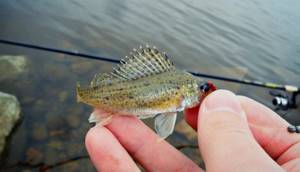
It is more difficult to catch a ruffe in hot weather than in cooler seasons. This fish loves the coolness in the shade. In summer, the ruffe is passive, lives at great depths or seeks shelter under water among snags. Found in places where tree branches hang over the water. Active biting in summer is rarely observed, since the fish do not eat for most of the day. At noon it spends its time rather inertly, “coming to life” only in the evening and in the morning.
Ruffs love cool water, so it’s worth looking for places with cold spring water. The best time to catch remains early morning, dusk or night.
Before fishing, use protein baits with sufficient addition of bloodworms and soil as complementary food. A good catch should be expected in rainy or cloudy weather. In bad weather, the heat subsides, the fish feels confident and comes out of hiding. It is difficult to catch a spiny predator near the bank of a wide river. It is worth going to the pier or fishing from a barge or raft. In this case, it is better to use winter types of fishing rods with a nod or short float rods.
We recommend reading: Catching pike perch at night with a spinning rod
Kinds
The ruffe is an unpretentious fish and feels good in both cool and warm water. In this case, the ruffe selects areas of the reservoir with a sandy, rocky or slightly muddy bottom. The fish is quite demanding on the concentration of oxygen in the water, as well as on the intensity of the current. The predator does not like areas with standing water, shallow water, or fast currents. Such restrictions leave their mark on the habitat of ruffes. Therefore, fish can be found in large and small rivers, in canals, in reservoirs, in lakes and ponds, but with running water.
Due to the fact that the ruff can withstand significant changes in water temperature, it is found almost everywhere. The ruffe inhabits all bodies of water included in the basin of the Baltic, Black, Azov and Caspian seas. Other species, compared to the common ruffe, inhabit water bodies located in regions with warmer winters.
Don ruff
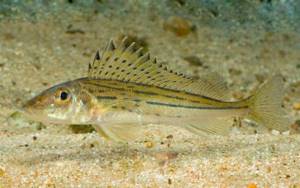
This species is better known by other names such as privet, beaver or nosy. Inhabits water bodies of the Black Sea-Azov basin. Significant populations of this species live in Europe, in rivers such as the Southern Bug, Dnieper and Dniester. It differs from its relatives with a wedge-shaped head and an elongated snout. This species has a retractable mouth, a white belly, and a light yellow back. It grows up to 20 cm in length and gains weight up to 200 grams. In Ukraine it is considered an endangered species, therefore it is listed in the Red Book.
Ruff Baloni
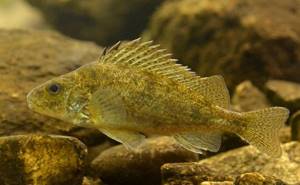
This species of ruffe prefers to be in deep-sea areas with running water, in close proximity to the coastline with high steep banks in the shade. It does not like areas with a soft bottom, so it stays in areas with a sandy, clay or gravel bottom, as well as in mixed areas. The lifespan of the species is about 6 years. During this period, the fish grows in length up to 17.5 cm, while gaining a weight of about 45 grams. It also has a second name – Czech ruffe, as it is found in the basins of the Morava, Vltava, and Laba rivers. The taxon is also found in the Danube, Dnieper and Pripyat rivers. It differs from its relatives in having a more humpbacked body, a short but flattened snout, two spines on each gill cover, and also a unique tiger-like gray-yellow color.
Striped ruff
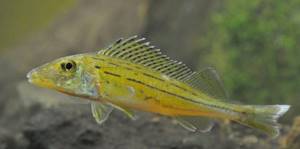
This type of ruff is distinguished by its more impressive size, as it grows to almost 30 cm in length and weighs about 250 grams. At the same time, fishermen’s catches are dominated by individuals no more than 18 cm in length and weighing about 70 grams. Found in water bodies of Germany, Bulgaria and Ukraine. The main difference is the presence of 3-4 full or dotted stripes running along the body and located on the sides, which have an olive-yellow tint. The mouth is semi-lower retractable, and the snout is slightly elongated. The dorsal fin is fused and has up to 19 hard rays.
Black Sea scorpionfish
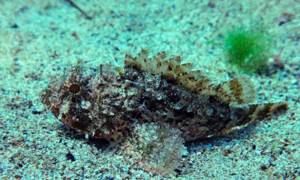
This species of ruffe represents the genus of scorpionfish and differs in only one similarity with its lake-river counterparts - a set of spines. It is found exclusively in salt water and is a fairly tough predator. This ruff has a huge mouth, and the lower jaw is somewhat elongated. As it develops, this fish sheds its skin like a snake, which becomes tight for the predator. Another rather important feature is that ruffs of this species have poison in their fins and bone spines. It can grow up to 40 cm in length, while gaining a weight of about 0.8 kg. The main populations of the Black Sea ruffe are located in the salty waters of the Eastern Atlantic, as well as in the Black Sea, Azov and Mediterranean seas. The Black Sea ruffe has quite tasty and healthy meat if cooked correctly.
